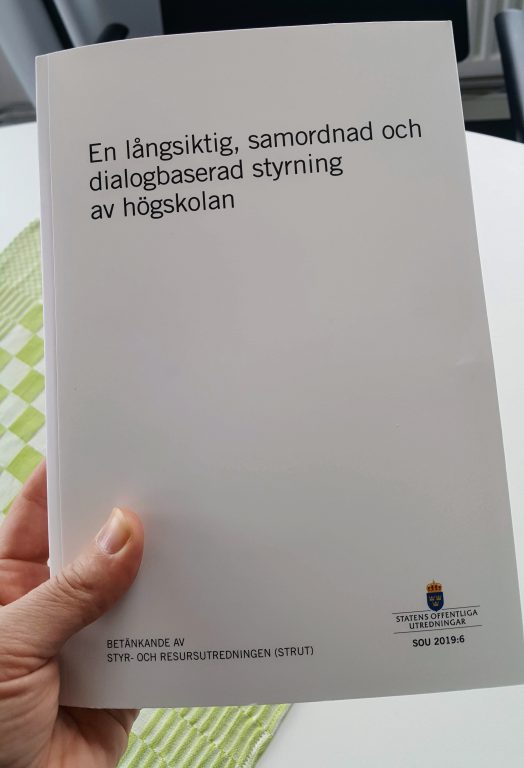English version below

Pam Fredman, regeringens utredare, har nu lagt fram sitt betänkande En långsiktig, samordnad och dialogbaserad styrning av högskolan (”Struten”), och presenterade den vid ett välbesökt seminarium i Stockholm i veckan. Målen med utredningen har bland annat varit att tydliggöra högskolans roll i samhället, förtydliga ansvarsfördelningen mellan regering och högskola samt att föreslå en ändamålsenlig styrning. Utredningen är på 467 sidor och en kunskapskälla för historieintresserade avseende lärosätenas olika styrformer sedan början av 1900-talet. För den framtida styrningen av lärosätena innehåller den förslag om: en samlad proposition för högre utbildning och forskning som ersätter nuvarande forskningsproposition (ett tydliggörande av den nära kopplingen mellan forskning och högre utbildning); en dialogbaserad process mellan regering och lärosäte för bättre planeringsförutsättningar; en ny analysfunktion för oberoende analyser och uppföljning av politiken; och att samverkan skrivs fram tydligare i högskolelagen.
Avseende resurser föreslås ett anslag med två ramar: grundutbildning och forskning. För utbildningen föreslås dels en styrmodell, som SLU redan har men som är ny för lärosäten under utbildningsdepartementet, nämligen att mål ges om antal helårsstudenter och att en ekonomisk ram tilldelas lärosätet för detta. Utöver det föreslås en fast bas som inte styrs av antalet helårsstudenter. Syftet är att skapa incitament för att ge utbildningar för det livslånga lärandet. För forskningen föreslås en större andel (minst 50 procent) direkta anslag till lärosätena. Eftersom utredningens förslag måste vara kostnadsneutrala föreslås att om sektorn inte tillskjuts mer resurser kan detta finansieras genom omfördelning mellan forskningsfinansiärer och lärosäten. Det finns mer att hämta ur rapporten och vi behöver analysera den noga inför remissvar. Ambitionen är att, utöver de enskilda lärosätenas egna svar, Sveriges samlade lärosäten ska ge ett gemensamt remissvar på det som vi är överens om för att stärka chanserna till en reell påverkan inför riksdagens och regeringens ställningstagande till betänkandet. Det handlar faktiskt om lärosätenas framtid.
Veckan avslutades med utbildningsdagar för nya förtroendevalda studenter och programstudierektorer. Det är en fin tradition som anordnas av SLU och SLUSS gemensamt med främsta syfte att stärka studenternas inflytande i grund- och forskarutbildningsfrågor. Det är på den unga generationen som framtiden vilar. De är framtidens forskare, yrkesarbetande och beslutsfattare. Dialogen med studentkårerna är därför central för att SLU ska kunna ge studenterna de bästa förutsättningarna och för studenterna att ta ansvar för sitt lärande!
Karin Holmgren, rektor
New proposal for higher education institution governance
Government analyst Pam Fredman has now submitted the report “En långsiktig, samordnad och dialogbaserad styrning av högskolan” (the Governance and Resource Inquiry) and presented it at a well-attended seminar in Stockholm last week. The aims of the investigation were, among other things, to clarify the role of higher education institutions in society, clarify divisions of responsibility between the government and higher education institutions and propose suitable governance methods. The report is 467 pages long and a source of knowledge for those interested in the history of higher education institution governance since the early 1900s. In regard to future governance, it includes proposals on the following:
- a joint government bill for higher education and research to replace the current research bill (a clarification of the close link between research and higher education);
- a dialogue-based process between the government and higher education institutions for better planning conditions;
- a new analysis function for independent analyses and policy follow-up, and
- highlighting external collaboration in the Higher Education Act.
In regard to resources, the report proposes a two-framed grant: first-/second-cycle education and research. Also proposed is an educational governance model that is already familiar to SLU, but which is new to higher education institutions reporting to the Ministry of Education and Research. The model involves establishing an FTE (full-time equivalent) objective and assigning a higher education institution a financial framework. Furthermore, the report proposes a fixed base not governed by the amount of FTEs. The purpose is creating incentives for organising lifelong learning courses and programmes. For research, the report proposes a greater amount (at least 50 per cent) of direct funding to higher education institutions. Since the report proposals must be cost-neutral, it suggests that if additional resources are not allocated to the sector, this can be funded by redistributing resources between research-funding bodies and higher education institutions. The report includes so much more, and we need to analyse it thoroughly before submitting our opinion. The ambition is that, in addition to individual higher education institutions submitting their own opinions, all Swedish institutions will submit a joint opinion on the aspects we agree on to strengthen our chances of making a real difference to the Riksdag’s and government’s standpoint on the report. After all, it concerns the future of all higher education institutions.
Last week concluded with training days for students and programme directors of studies elected to an office. It is a lovely tradition arranged by SLU and Sluss together, and the primary aim is strengthening student influence on education issues at all levels. After all, the future rests with younger generations. They are the researchers, professionals and decision-makers of the future. The dialogue with the students’ unions is key in order for SLU to provide our students with the best conditions and for the students themselves to take responsibility for their learning.
Karin Holmgren, Vice-Chancellor
